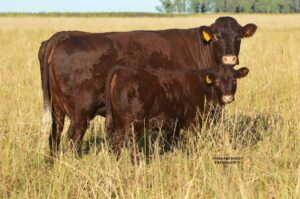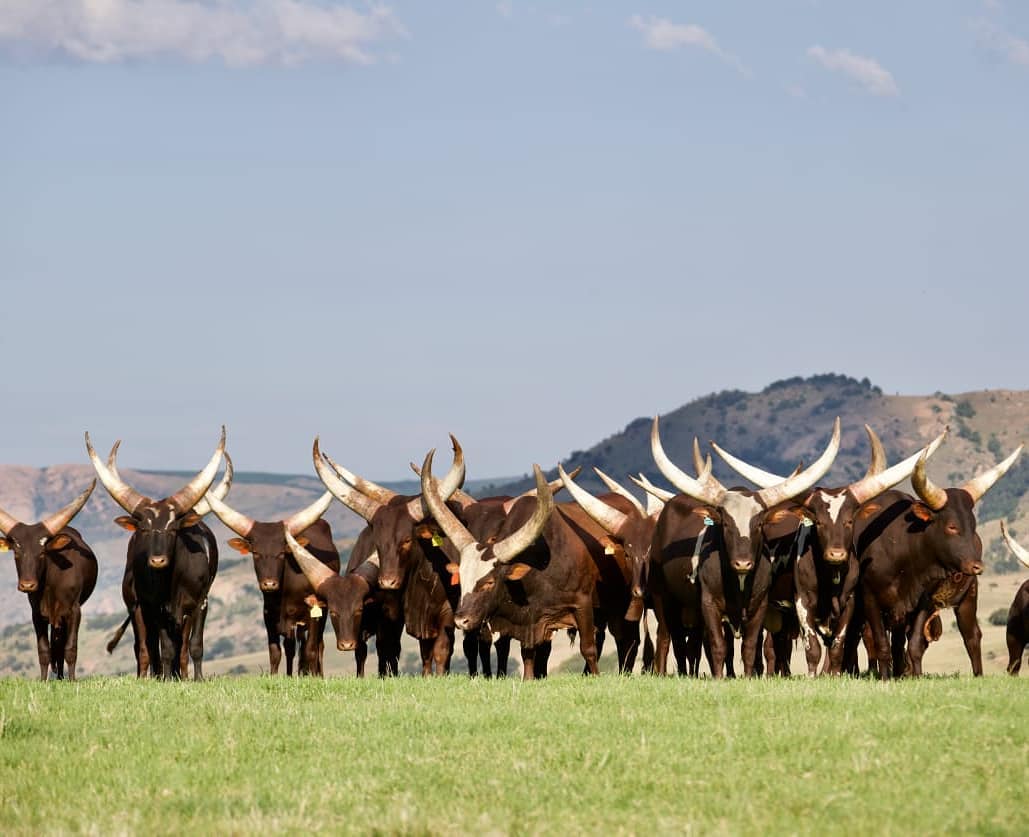Sussex
Sussex cattle are one of the oldest and purest English breeds and are popular in Southern Africa’s beef industry. The breed descended from horned red cows once found in Sussex and Kent in southern England. These cattle were draft animals for years before ultimately being slaughtered for beef at the age of 6 years.
The Sussex is a medium-sized, early maturing beef animal with a smooth, hereditary red coat and a white tail. The breed’s easy-to-handle temperament has earned it the nickname “trouble free.” The breed is a part of the Bos taurus group.
The cows’ maternal instincts, abundant milk supply, high calving rates, and excellent fertility demonstrate their versatility. Cows’ average weight is 520 to 620 kg; bulls have muscle and depth, and their average weight is 850 kg.
Breeders must dehorn naturally horned Sussex animals. Breeders use polled bulls to introduce polled genetics into their herds. Polled bull sperm has been imported, and polled genetics are available.
Sussex cattle mature early, so they can be sold right off the veld or pastures. It is a good converter of concentrate feeds and gains weight quickly, so feedlot operators like them.

Well-muscled Sussex bull. (Source: Facebook by Sussex Cattle Breeders’ Society of SA)
Production regions
In South Africa, Namibia, Zimbabwe, and Botswana, Sussex Stud breeders can meet the demands of commercial cattle farmers.
Sussex animals can tolerate the harsh cold of the Drakensberg and Eastern Cape mountains as well as the sands of the Kalahari Desert and the warm bushveld of Africa. This demonstrates their extraordinary adaptability and superior heat resistance.
Uses
Purebred and crossbred Sussex cattle perform well. Bulls are pre-potency hardy, show a good weaning weight, and excellent post-weaning growth. Sussex bulls add weaning weight to crossbreeding programmes.

Sussex cow and calf. (Source: Facebook by Sussex Cattle Breeders’ Society of SA)
Sussex bulls with the $X brand mark on their left shoulder have been visually inspected by a senior inspector of the Society. When using Sussex bulls, farmers should make sure they have the $X brand.
A Sussex stud breeder gives commercial beef producers high-quality bulls that work well to improve the quality and profitability of beef.
Meat quality
The Sussex breed produces high-quality meat.
Tuli
African cattle are categorised by humps. Zebu cattle have humps on the thorax, while Sanga cattle have them on the neck. According to DNA tests, Tuli cattle are part of the Sanga group, which dates back over 2 000 years. Migrating tribes brought these early animals to Southern Africa, where they thrived south of the Zambezi. The Tuli is “fertile, profitable, range cattle”, according to the Society’s logo.
This pure indigenous breed has qualities that beef farmers value. It has a medium body size, high fertility, is mostly polled, has easy birthing, longevity, hardiness, and adaptability that have been bred into it over at least 2 000 years by natural selection. This makes the breed naturally resistant to both internal and external parasites.
Scientific selection recently focused on economic value, resulting in the modern Tuli. Never has the breed’s hardiness and adaptability been compromised. They tend to have solid white, red, brown, and yellow coloration.

Tuli cows and calves. (Source: Facebook by Tuli Cattle Breeders’ Society of SA)
Tuli cows have good fertility, milk production, and low calf mortality with an average weight of 400 to 500 kg, and Tuli bulls have a good feed conversion ratio and carcass quality with an average weight of 750 to 850 kg. The breed is a part of the Bos taurus africanus group.
Production regions
Southern Africa produces the Tuli breed because of its adaptability, hardiness, and capacity to produce high-quality meat from even the worst quality grazing.
The breed does well in sandy, semi-desert areas like Namibia, Botswana, and the Northern Cape. It also does well in hot heartwater bushveld areas like Zimbabwe, Limpopo, and the Lowveld of Mpumalanga, as well as in high rainfall, sour veld, and high-altitude areas of Mpumalanga, and in KwaZulu-Natal, where redwater, gall sickness, and cold conditions with snow are common.

Tuli bull with some cows. (Source: Facebook by Tuli Cattle Breeders’ Society of SA)
Uses
The Tuli is particularly effective in crossbreeding programmes due to its distinctive genetic make-up, which produces good hybrid vigour and a high proportion of polled calves. Additionally, compared to many other breeds, Tuli steers and Tuli-cross calves finish quicker on the veld.
Meat quality
Of all the breeds in the world, the Tuli has the highest rib-eye to carcass ratio. Due to the hardiness of the breed, their meat can actually be labelled as “grass fed” because it can be “fattened up” on the land.
Wagyu
The name Wagyu refers to two Japanese cattle breeds and means “Japanese cow”. Buddhist leaders strictly forbid eating meat, so these cattle were chosen for their strength. Marbling is the succulent, flavourful intermuscular fat. Wagyu beef used to only be eaten by royalty and samurais in Japan because it was so good.
International production accounts for 0,2% of premium meat breeds. Raising awareness of the excellent meat quality will continue to increase demand.
South Africa produces both red and black wagyu. Akauishi has excellent marbling, fertility, and growth. They resemble South African red cattle. The Japanese black has even more marbling than the Akauishi, and is ideal for the “boutique” meat market and exports. The cows weigh an average of around 450 to 560 kg and bulls can weigh up to 950 kg. The breed is a part of the Bos taurus group.

Two Black Wagyu cattle (Japanese Black). (Source: Facebook by Wagyu South Africa)
Production regions
Due to their high adaptability, Wagyu cattle are raised all over Southern Africa. The Wagyu Society encourages its use in crossbreeding with native breeds like the Nguni, Bonsmara, and Beefmaster, which are primarily British and indigenous, in order to improve the meat quality and fertility of these breeds.
Uses
In accordance with the breed definition, the term “Wagyu” may only be applied to cattle that are first-line crosses with a minimum of 50% breed content or to registered full-blood or purebred bulls. Farmers must follow a number of moral and animal welfare rules, keep accurate production records, and castrate bull calves not intended for breeding before they are five months old.

An Akaushi or Red Wagyu (Japanese Brown) cow and calf. (Source: Facebook by Wagyu South Africa)
Meat quality
The meat must be hormone-free and have a marbling score of at least three
Ankole
Ankole cattle are raised for beef in South Africa. This breed dates back to ancient Egyptian hieroglyphs and has been part of the longhorn cattle tribes for over 6 000 years. The breed migrated down the Nile to Uganda, the Pearl of Africa.
The Banyankole people of Western Uganda, after whom the Ankole was named, believe God created the breed and gave it to the Ankole Kingdom’s founders. The Ankole are “Kings’ Cattle”.

Ankole bull with magnificent horns. (Source: Facebook by Ankole Cattle Breeders’ Society of South Africa)
Dual-breed cattle are known for their lean meat and high-quality milk. They have majestic, ivory-looking horns that point to the African sky. Horns connected to airways help cattle regulate their body temperature.
Roan, strawberry, dark to light brown, and red are some of the coat colours. In the past, Ankoles were managed by their coat colours, body types, behaviour, and horn shapes. The cows weigh an average of around 400 to 540 kg, and bulls can weigh an average of 450 to 720 kg. The breed is a part of the Bos taurus group.
Production regions
The breed can do well in most of Southern Africa because it can adapt to different climates.
They have the capacity to acclimate to harsh and extreme weather, from cold and rainy to hot and dry desert climates. They are a strong and useful breed because they can survive on low-quality forage and have a high level of disease and tick resistance.
Uses
The breed may be used alone, but due to its extensive use in crossbreeding programmes in Uganda, it has come under threat over time. Lots of milk are produced by the cows, which are valued in Uganda and is reportedly both tastier and healthier than milk from traditional dairy breeds.

Ankole cow and calves. (Source: Facebook by Ankole Cattle Breeders’ Society of South Africa)
Meat quality
The meat is tasty, lean, low in cholesterol, and rich in omega-3 and omega-9 fatty acids. According to the Ankole Cattle Breeders Society of South Africa, it will undoubtedly attract the attention of customers and markets who are concerned about their health.
References
Southafrica.co.za. (2022). South African Beef Breeds. [online] Available at: https://southafrica.co.za/south-african-beef-breeds.html
Loubser, A., Schutte, N. and Hofmeyr, I., (2007). Cattle breeds of South Africa. Pretoria, AgriConnect, Pages 97-165.








